Yuan Ying, Sun Rongxia, Li Rui, Wang Shuo Nan
(Hebei University, School of Electronic Information Engineering, Baoding, Hebei 071002)
Abstract: In order to monitor and study the impact of environmental parameters on photovoltaic power stations, a real-time monitoring system based on ZigBee technology is proposed. Using the CC2530 chip as the control core, hardware circuits for sensing nodes, routing nodes, and gateway nodes are implemented. Based on the Z-STACK protocol stack, an improved Cluster-Tree algorithm is applied to form a wireless sensor network. The Yeelink IoT platform is utilized for upper computer monitoring, allowing researchers to remotely log into the Yeelink platform and mobile APP to view the environmental status of photovoltaic power stations. Experimental tests show that the system achieves real-time monitoring of temperature, humidity, light intensity, and atmospheric pressure information in photovoltaic power stations, with high data reliability and a data packet reception rate exceeding 75% for the gateway node.
Keywords: Photovoltaic power station; ZigBee; Real-time monitoring; Yeelink
Classification Number: TP182 Document Identification Code: A DOI: 10.19358/j.issn.1674-7720.2017.03.010
Citation Format: Yuan Ying, Sun Rongxia, Li Rui, et al. Real-time monitoring system for photovoltaic power stations based on ZigBee technology [J]. Microcomputer and Applications, 2017, 36(3): 33-35, 38.
1 Introduction
The localization research on RF power supply devices in solar cell production key equipment (11213910D) has shown that energy shortages and environmental degradation have become important factors restricting economic growth in various countries. To reduce energy consumption, countries are exploring new energy technologies, with photovoltaic power generation being an indispensable part of new energy. Although significant research achievements have been made in photovoltaic power generation technology in China, there are still technical issues that need further research [1], one of which is to improve the conversion efficiency of photovoltaic power generation. The photoelectric conversion process of photovoltaic cells is influenced by environmental parameters such as temperature, humidity, and light intensity, while the environmental data for researchers studying photovoltaic power generation conversion rates is very scarce, severely restricting the development of photovoltaic technology. In addition, most domestic photovoltaic power stations are built in remote areas and generally operate unattended, and the environmental monitoring systems for photovoltaic power stations are fixed installations from the beginning, making it inconvenient for mobile disassembly and unable to comprehensively monitor the surrounding environment [2]. Therefore, to improve the accuracy and timeliness of environmental data transmission for photovoltaic power generation, and to facilitate researchers’ comprehensive management and analysis of monitoring data, this paper designs and implements a real-time monitoring system based on IoT technology and ZigBee technology, which can collect temperature, humidity, light intensity, and atmospheric pressure information from multiple points in photovoltaic power stations and perform remote real-time monitoring.
2 System Overview
This system includes two parts: a wireless sensor network and a remote control center. The ZigBee wireless sensor network consists of one gateway node, multiple router nodes, and multiple sensing nodes [3]. According to the ZigBee protocol specification, the network topology structure includes star, mesh, and tree structures. This design adopts a tree topology structure to improve the reliability of WSN data transmission and reduce network complexity. The remote control center mainly includes the Yeelink IoT platform and monitoring terminal, as shown in the system structure block diagram in Figure 1.
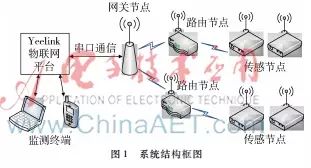
The system collects the temperature, humidity, light intensity, and pressure information from the photovoltaic power station site through sensing nodes, processes the data through circuits, and forwards it to the routing nodes via the ZigBee module; the routing nodes mainly complete data forwarding to achieve long-distance communication. The number of sensing nodes and routing nodes can be flexibly configured according to environmental needs. The gateway node is responsible for establishing and managing the network [4], sending the received data to the Yeelink platform via serial communication. Monitoring personnel can remotely log into the Yeelink platform through a computer or mobile monitoring terminal to directly monitor the on-site environment without needing to be on-site.
2.1 Node Hardware Design
The node hardware design adopts a modular design philosophy, using the CC2530 chip as the main control chip to design each node. The node structure mainly includes the ZigBee module, acquisition module, LCD display module, communication module, and power supply module, as shown in the node hardware structure diagram in Figure 2.
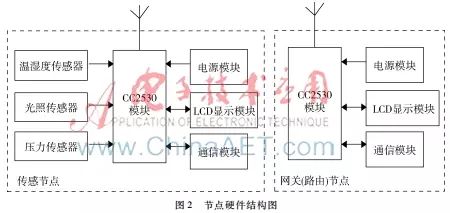
In this system, the ZigBee module of each node uses the minimum system of the enhanced chip CC2530. The CC2530 not only serves as the core chip of the ZigBee module for wireless communication of collected data but also acts as a microprocessor for control. The selected CC2530F256 integrates a high-performance 2.4 GHz RF transceiver and a low-power industrial-grade 8051 microcontroller [5]; its current consumption in receive and transmit modes is 24 mA and 29 mA, respectively, making it particularly suitable for ultra-low power applications requiring long-term battery power. Due to its low power consumption, high integration, simple hardware design, and rich peripheral interfaces, the CC2530 is widely used in wireless sensor networks. This module adds a data storage circuit for storing collected information, allowing for retrieval and retransmission of stored content in case of data loss during transmission. The circuit is shown in Figure 3.

2.2 Acquisition Module
The acquisition module collects temperature, humidity, light intensity, and pressure parameters from the power station site through sensors, and the accuracy of these parameters is crucial for researchers to obtain environmental parameters in a timely manner. This design selects low-cost, high-precision, and stable sensors, including the digital temperature and humidity sensor SHT11, light-dependent resistor 5516, and high-resolution digital pressure sensor MS5611-01BA03, with the technical parameters of the selected sensors shown in Table 1.

2.3 LCD Display Module
In this system, the data display for the field terminal nodes and coordinator nodes is achieved using the ZLE12864A LCD display module, which displays the date, time, temperature, humidity, light intensity, and pressure values in real-time. The display module in this design uses a 3.3 V power supply and communicates with the main control chip via serial communication [6]. The liquid crystal circuit control chip is ST7565P. The display module pin connections are SCLK→CC2530(P1.5), MOSI→CC2530(P1.6), Pin12→CC2530(P1.2), Pin13→RST, and Pin14→CC2530(P0.0).
2.4 Power Supply Module
The power supply module is key to ensuring the normal operation of the system. Since each circuit of the system requires 3.3 V power supply, while each node uses a 5 V dry battery, the LM117 voltage regulator chip is used to convert the 5 V voltage to 3.3 V. The power supply module circuit diagram is shown in Figure 4.
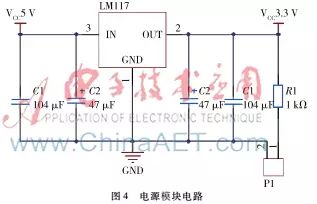
3 System Software Implementation
3.1 ZigBee Routing Algorithm
This design applies an improved Cluster-Tree routing algorithm. The traditional Cluster-Tree algorithm does not require storing routing tables, making it simple, but it relies solely on the parent-child relationship between nodes to forward packets, increasing average delay and hop count [7]. Based on the traditional algorithm, a neighbor table is introduced to compare the hop counts from the current node to the target node and from neighbor nodes to the target node, selecting the better path between forwarding data to neighbor nodes and directly sending it along the target node. The specific process of the algorithm is shown in Figure 5 (Ds is the network depth of the source node, Dd is the network depth of the target node). During the data transmission process, the improved algorithm is repeatedly used for calculation until it reaches the target node. The improved Cluster-Tree algorithm introduces a mechanism that combines the neighbor table with hop count calculations between nodes, looking for a path with fewer hops before a node sends or forwards a data packet. The improved algorithm effectively reduces energy consumption and enhances data transmission efficiency.
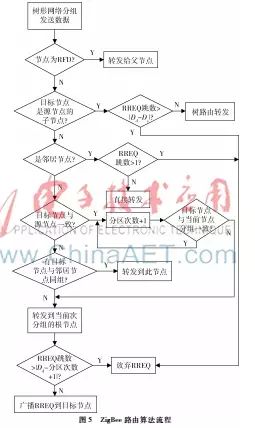
3.2 Node Software Implementation
The gateway node is the core of the wireless sensor network, responsible for building the tree network, receiving, processing, and sending all information and instructions. The gateway node starts and initializes the system, then scans for a suitable channel and builds the wireless sensor network [8]. After successful networking, it begins to receive data transmitted from nodes and forwards it to the Yeelink platform, then sends instructions to the nodes.
The sensing nodes are responsible for collecting and transmitting temperature, humidity, light intensity, and atmospheric pressure information from the power station site. After powering on and initializing, the nodes scan the network channel and request to join the scanned wireless network. Once successfully connected, they begin information collection and transmission. The acquisition nodes are set to a periodic working mode, entering a sleep state to reduce energy consumption when data collection is not needed.
3.3 Yeelink Platform Integration
With the rapid advancement of IoT technology, public service platforms for IoT are increasingly used to store and manage sensor data and display it to users in real-time through computers and mobile apps. Yeelink is a widely used platform in China. This design utilizes the Yeelink platform to display and store data and control the environment, using the Yeelink serial tool and the COM2 port of the network computer to communicate with the IoT platform.
4 Testing and Result Analysis
After the system is completed, system tests are conducted, mainly testing the measurement accuracy of the system, the data packet reception rate of the gateway node, and the stability of system operation. To ensure the smooth conduct of the experiment, the tests are conducted in a laboratory environment; the test subjects are the temperature, humidity, light intensity, and atmospheric pressure of indoor air; three sensing nodes are placed indoors. The experiment began on March 11, 2015. Due to environmental constraints, a humidifier, simulated light source, and air conditioning were used to adjust temperature, humidity, and light intensity.
Taking temperature as an example for testing and analysis, the sensing nodes used the SHT11 temperature and humidity sensor (accuracy ±0.4℃, ±3.0% relative humidity), and the comparative test used a portable temperature and humidity meter from Chuan Yi (accuracy ±0.1℃, ±0.1% relative humidity). From the temperature comparison results in Figure 6, the temperature parameters collected by the system differ little from the values of the temperature and humidity meter, with the temperature error maintained within ±0.5℃, which is acceptable for photovoltaic power station use.
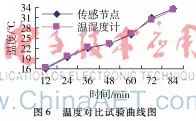
Figure 6 Temperature Comparison Test Curve Through comparative testing, it can be seen that the system’s temperature error remains within ±0.5℃, and humidity error remains within ±1.8%. The pressure comparison test used a 370 digital standard barometer, with the pressure difference maintained around ±1.4 hPa. When the distance between nodes is within 80 m, the data packet reception rate of the gateway node is over 75%; when the distance exceeds 80 m, the reception rate decreases significantly. Therefore, to ensure data transmission reliability during network deployment, the distance between nodes should not exceed 80 m. Through continuous testing, the system can promptly reflect the collected environmental parameter information, and remote login to the Yeelink platform is available to view environmental information through the monitoring terminal.
5 Conclusion
To achieve real-time monitoring of environmental information in photovoltaic power stations, a real-time monitoring system based on ZigBee technology has been designed. This system designs the hardware circuits and software programs of each node with CC2530 as the control core. At the same time, the improved Cluster-Tree algorithm conserves network resources and reduces energy consumption, ultimately building a flexible networking, easy installation, and low-power monitoring system that realizes real-time monitoring of temperature, humidity, light intensity, and atmospheric pressure parameters in photovoltaic power stations. After testing, the data collection reliability is high, the system is stable and reliable, and it has strong scalability, allowing for the integration of weather or other data into the system, with certain practical promotion value.
References
[1] Hu Yunyan, Zhang Ruiying, Wang Jun. The current status and prospects of solar photovoltaic power generation in China [J]. Journal of Hebei University of Science and Technology, 2014, 35(1): 69-72.
[2] Dai Zhijian, Lin Peijie, Cheng Shuying. Image acquisition system based on solar power [J]. Electronic Technology Application, 2012, 38(10): 41-44.
[3] Zigbee Alliance [DB/OL]. (2013-12-14) [2016-10-05]. http://contech.suv.ac.kr/contech/courses/11h2wsn/095262r 00ZB_rf4ce_sc-ZigBee_RF4CE_Specification_public.pdf
[4] Chen Ketao, Zhang Haihui, Zhang Yongmeng, et al. Design of a wireless sensor network gateway node based on CC2530 [J]. Journal of Northwest A&F University (Natural Science Edition), 2014, 42(5): 183-188.
[5] Wang Xin, Pan He. ZigBee wireless temperature and humidity monitoring system based on CC2530 [J]. Journal of Chinese Agricultural Mechanization, 2014, 35(3): 217-220.
[6] Wang Suqing, Wu Chao. Design and implementation of an environmental monitoring system based on CC2530 [J]. Computer Measurement and Control, 2015, 23(8): 2650-2653.
[7] Cao Yue, Hu Fangming, Dang Ni. Research on the optimized routing algorithm of ZigBee network Cluster-Tree [J]. Microcontrollers and Embedded Systems Applications, 2012, 12(10): 4-7.
[8] Feng Chenwei, Zhang Lin, Yuan Jiangnan. Design of an intelligent remote monitoring system based on ZigBee and Android [J]. Television Technology, 2015, 39(20): 38-42.

